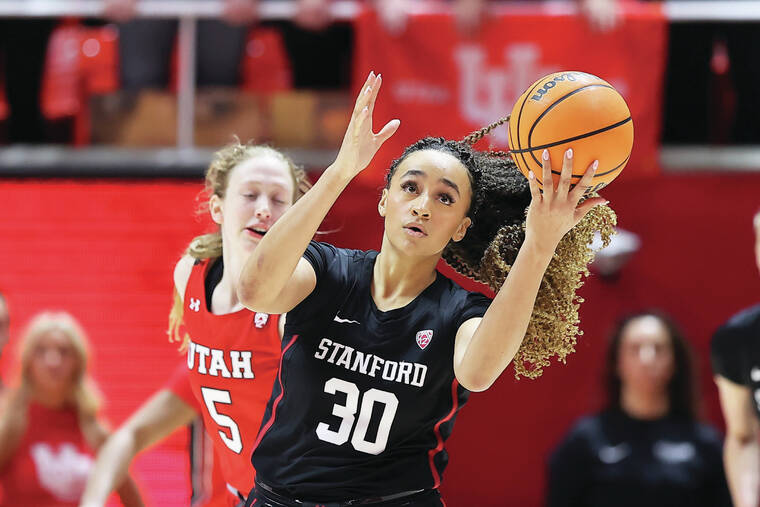Women making case in tourney for own March Madness TV deal
Women’s basketball seems to have found a winner with its new Sweet 16 format in March Madness and the timing couldn’t be better with looming TV contract negotiations on the horizon.
There were record-setting attendance at the two sites — Greenville, South Carolina and Seattle — along with record numbers for TV ratings. It fueled the momentum heading into a star-packed Final Four lineup in Dallas.
ADVERTISING
NCAA selection committee chair Lisa Peterson expects the format success to help in upcoming contract negotiations. The current NCAA TV deal ends next summer.
“It has to,” she said. “I’m very much looking forward to seeing those conversations. It only can be good for the game. People are talking about it.”
TV ratings for games on Friday and Saturday averaged 1.2 million viewers, a 73% increase over last year. Saturday afternoon’s Ohio State and UConn matchup on ABC was the most watched women’s Sweet 16 game on record with an average of 2.4 million.
Ratings were also up for the games Sunday and Monday on ESPN — up 43% gain and averaged 2.2 million. Sunday night’s Iowa-Louisville contest which featured dynamic guard Caitlin Clark led the way at 2.5 million, making it the most watched Elite Eight game on record.
Tag Garson, Wasserman’s senior vice president of properties, said this year’s ratings will be one of many pieces that factor into what path the NCAA will take.
“When you’re looking at how ratings are performing as you’re preparing for a negotiation you don’t just look at one year,” he said. “You’re looking at the historical value while projecting out the future value.”
The NCAA is expected to decide by this fall whether to separate the women’s tournament or keep it as part of the championships TV package that includes at least 24 sports.
Peterson and her group will have a lot to review.
Arenas in Greenville and Seattle were mostly full which created an entertaining atmosphere. While attendance was expected to be high in Greenville with the undefeated Gamecocks there. the closest team to Seattle was Colorado — 1,300 miles away.
The distance didn’t stop fans from flocking to Seattle, with strong support from basketball fans around the city thanks in part to the success of the WNBA’s Storm over the last two decades. In the end, the Seattle region outdrew its South Carolina counterpart by a few thousand. Overall 82,275 fans took in the Sweet 16 and Elite Eight games, including 43,556 in Seattle.
“It really was a great atmosphere to play in. You love to play in these kind of atmospheres with this kind of crowd and play in a great building like this,” said UConn coach Geno Auriemma whose team played in Seattle.
The NCAA also hopes the success leads to more cities bidding to host the regional games and eventually the Final Four.
“The number of cities that had bid (in the past), we didn’t have that many more options,” Peterson said. “With the success we’ve had hopefully it opens up new doors so we don’t keep going to the same cities.”
The local organizing committee in Seattle said that they expected the tournament to generate more than $8.3 million to the city.
“When we host events like this there’s no playbook to say it’s a guaranteed success,” Seattle Mayor Bruce Harrell told The Associated Press. “You don’t know how the fans are going to come out, but what has been proven time and time again, particularly around women’s sports is that they come from all over the state even come from Canada. … The revenue is incredible for our tax base.”
Harrell threw Seattle’s hat in the ring for a future women’s Final Four, saying he would love it if his city got that opportunity.
One of the next steps the NCAA is planning for upcoming two regional sites is to turn them into “mini Final Fours.”
Many fans seemed to enjoy the new format going to more than just their team’s games. Dave Lichliter, who is from Pennsylvania, went to games both Friday and Saturday and enjoyed the expanded field.
“You get to see more teams,” said Lichliter, who was wearing an LSU championship football shirt from 2019. “Next year is Albany (New York) and Portland (Oregon), so we’ll see how that goes.”
So will the NCAA.
The two-city format will be in place at least another three years.
The next bid cycle starts in July where regional hosting will be decided from 2027-31.
“We’re doing this for three years. It’s not a permanent deal,” Peterson said. “As always we’ll evaluate it.
If we feel it doesn’t work, we’ll see what we need to do to change it. Whether it’s changing formats, or if that’s adding a day, Whatever that looks like, we’ll keep looking at it.”
There were a few logistical bumps with the two sites.
With eight schools at one venue required some adjustments by teams and arena staffs. Practice time on the court was cut from 90 minutes to 60 to allow all eight time on the court.


